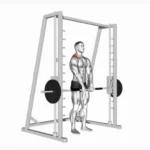Alternating Seated Dumbbell Curl: Exercise Overview
The alternating seated dumbbell curl is a targeted isolation exercise designed to build and strengthen the biceps brachii, with secondary engagement of the brachialis and forearms. Performed on a bench, this variation emphasizes unilateral movement, allowing each arm to work independently to address strength imbalances and enhance bicep definition.
Ideal for sculpting aesthetically pleasing arms, the alternating seated curl promotes focused muscle activation and is a staple in arm-focused workouts, upper-body sessions, or full-body routines. Its seated position minimizes momentum, ensuring proper form and maximizing bicep engagement (Schoenfeld, 2010). This exercise is suitable for lifters of all levels aiming for both aesthetic and functional arm strength.
How to Perform the Alternating Seated Dumbbell Curl
- Position a flat or adjustable bench and place a pair of dumbbells at one end.
- Sit on the bench with feet flat on the floor and knees together, grasping a dumbbell in each hand with a supinated grip (palms facing up), letting them hang at your sides—this is your starting position.
- Slightly bend your elbows to engage the biceps, keeping your back straight and elbows tucked close to your sides.
- Curl one dumbbell toward your shoulder, keeping the movement controlled and focusing on bicep contraction.
- Pause briefly at the top, squeezing the bicep, then slowly lower the dumbbell back to the starting position, maintaining tension.
- Repeat with the opposite arm, alternating sides for the desired number of repetitions.
Tips for Optimal Performance
- Minimize Body Movement: Keep your torso stationary and avoid leaning back to prevent momentum, ensuring the biceps do the work (McGill, 2010).
- Keep Elbows Tucked: Maintain elbows close to your sides throughout the movement to isolate the biceps and reduce shoulder involvement (Schoenfeld, 2016).
- Maintain Constant Tension: Keep slight tension in both biceps, even in the non-curling arm, to enhance muscle activation throughout the set.
- Control the Movement: Perform the curl and descent slowly to maximize time under tension and promote bicep growth.
- Breathe Properly: Exhale as you curl the dumbbell upward and inhale as you lower it to support controlled movement and muscle oxygenation (Wirth et al., 2016).
- Choose Appropriate Weight: Select dumbbells that allow you to maintain proper form for your target rep range (e.g., 8–12 reps per arm for hypertrophy) to avoid swinging.
Building biceps with alternating curls? Learn how they enhance arm power in our Ultimate Guide to Muscle Groups.







